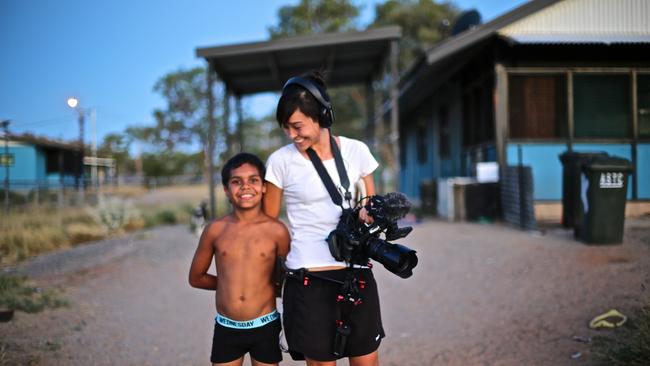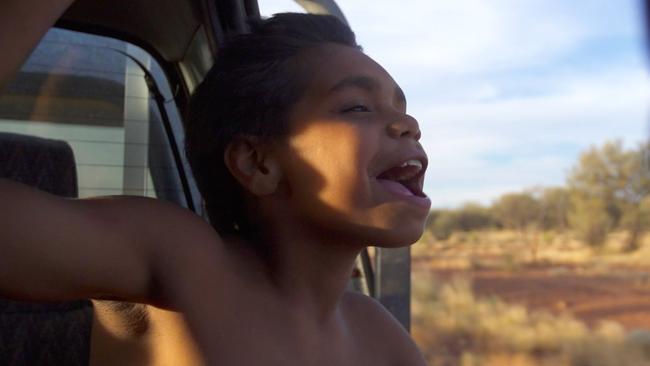History, culture and two-way learning: Alice Springs doco In My Blood It Runs
The need for Aboriginal children to have their identities, language and culture valued and taught in our education system inspires In My Blood It Runs.

Maya Newell’s documentary takes its title from the words of its young subject.
In My Blood It Runs introduces us to Dujuan Hoosan, a 10-year-old who lives in the town camp of Hidden Valley, outside Alice Springs. It also introduces us to the people around him: family members and elders intent on supporting him in every possible way, his mother, grandmothers, members of the community and, later in the film, his father.
He is a compelling subject. “When I met Dujuan,” Newell says, “he was this exuberant, witty, intelligent, cheeky young kid, the character you see in the film.” He displayed “absolute confidence. He really wanted a film made about him. He was glued to the camera, interested in filmmaking as well as speaking.”
At 10, he was also of an age, she says, “when children become aware of the complex adult world around them. And in Alice Springs, that’s a lot.”
Dujuan is growing up quickly, and there is a poetic quality to the way he sees the world.
“I was born a little Aboriginal kid,” he says, reflecting on who he is and where he comes from. “History, in my blood it runs.”
Newell says she saw a “childlike wisdom and moral code” in her protagonist. “And I felt a lot of Australians would find great value in learning from him and listening to him,” she says. For audiences, part of this involves understanding the ways in which Dujuan is silenced or overlooked, particularly in the education system.
Newell started working with Dujuan and his family almost four years ago, but the origins of the documentary go back much further. “The intimacy you see on screen is the result of over 10 years of relationships and trust with Arrernte people in Alice Springs, and that is the foundation of the film.”
She has been working with the Akeyulerre Healing Centre, where she made films with families as they did “incredible, empowering work” in educating their children with language, culture and identity.
The films were shorts, educational tools not intended for public consumption, “private recordings of cultural knowledge” that would be available for future generations. Along the way, Newell says, she “went on a long journey of listening and learning, and being gently guided”.
At a certain point, people discussed the possibility of making a feature-length film for broader audiences. One of the recurring themes was the need for Aboriginal children “to have their identities and language and culture be respected and valued and taught in our system”, Newell says.

“So we sat down and thought, let’s make this film for the wider public about how we measure success in Australia and what it feels like to be a First Nations child in the classroom.”
She quotes elder and adviser Margaret Kemarre Turner: “They’re always telling us to get our kids ready for school, but when are they going to make schools ready for our kids?”
In the film, Dujuan’s grandmother talks about wanting her grandchildren to be educated at school “so they know the system when they grow up”, as well as learning their own culture and language.
Yet at his Alice Springs school, the teacher reads from a textbook more than 60 years old, telling Dujuan and his classmates about the arrival of James Cook, who, “on an island off Cape York raised the English flag and claimed for the English country the whole of this new land”. Later, the teacher reads from a book about “the Spirit and the Dreaming” and seems acutely uncomfortable about the content. “But we’ve just got to believe it,” she says awkwardly.
In My Blood It Runs is intimate and observational, but it also uses small amounts of archival footage that functions in a range of ways.
“Living in a country in a state of denial,” Newell says, “we need to do so much work to understand why history is so important for the present.
“Here is a child who is saying, ‘History is in my blood. I am the summation of history. I can feel that, I have a memory of it.’ It’s part of his every day, it’s taught in the classroom, it’s how he’s spoken to on the street. And we wanted to create a representation of his concept of memory.”

The archive, she says, relates to stories of oppression and of resistance. “It’s part of the tapestry of who he is, of his identity, of stories he’s told at home that don’t necessarily exist in our history books.”
In preparing to make the film, Newell says she was very aware of the politics of representation and of being a non-indigenous person. “So we created a structure of creative control which meant that agency sat with family. We’ve got a detailed document and plan that keeps us accountable.”
In practice, she says, “we all know that each of us has implicit bias. I’m there as the director with the camera, and we can’t take that away, but what we can do is try to create consultation and voice around the project.

“Megan, Dujuan’s mum, said: ‘I just want the film to show how we care about our kids.’ It’s not a narrative she sees when she turns on the TV or opens a newspaper or goes on social media.”
That theme, Newell says, is a strong element in the film. There were challenges that arose during filming, too, “intense scary things” that had not been anticipated. When this happened, people sat down and watched the footage and talked about it, often opting to include it.
There are times when things look bleak for Dujuan. But in the end, Newell says, “Every solution that works for him is derived from his family, not from the systems that are meant to uplift him.”
In My Blood It Runs opens on Thursday.

To join the conversation, please log in. Don't have an account? Register
Join the conversation, you are commenting as Logout